Broad-Scale Surface and Atmospheric Conditions during Large Fires in South-Central Chile
Abstract
:1. Introduction
2. Materials and Methods
2.1. Study Area
2.2. Climate Context
2.3. Data
2.3.1. Fire Dataset
2.3.2. Fire Data Trend Analysis
2.3.3. Climate Dataset and Analysis
3. Results
4. Discussion
5. Conclusions
- The persistence of anticyclonic anomalies (high pressure systems) located over the southeast Pacific Ocean off southern Chile.
- Warm surface conditions (maximum temperature) throughout a large area (ca. 34–45° S) of south-central Chile.
- Easterly surface wind anomalies linked to reduced onshore westerly ventilation of cooler oceanic winds to the south-central Chilean land-surface.
- At broader spatial scales, a circumpolar chain of high-pressure systems at subtropical latitudes and low pressure around the Antarctic periphery (i.e., patterns associated with positive SAM).
Supplementary Materials
Author Contributions
Funding
Data Availability Statement
Conflicts of Interest
References
- Bowman, D.M.; Moreira-Muñoz, A.; Kolden, C.A.; Chávez, R.O.; Muñoz, A.A.; Salinas, F.; González-Reyes, Á.; Rocco, R.; de la Barrera, F.; Williamson, G.J.; et al. Human–environmental drivers and impacts of the globally extreme 2017 Chilean fires. Ambio 2019, 48, 350–362. [Google Scholar] [CrossRef]
- Flannigan, M.D.; Krawchuk, M.A.; de Groot, W.J.; Wotton, B.M.; Gowman, L.M. Implications of changing climate for global wildland fire. Int. J. Wildland Fire 2009, 18, 483–507. [Google Scholar] [CrossRef]
- Moreira, F.; Viedma, O.; Arianoutsou, M.; Curt, T.; Koutsias, N.; Rigolot, E.; Barbati, A.; Corona, P.; Vaz, P.; Xanthopoulos, G.; et al. Landscape—wildfire interactions in southern Europe: Implications for landscape management. J. Environ. Manag. 2011, 92, 2389–2402. [Google Scholar] [CrossRef] [Green Version]
- Whitlock, C.; Higuera, P.E.; McWethy, D.B.; Briles, C.E. Paleoecological perspective on fire ecology: Revisiting the fire regime concept. Open Ecol. J. 2010, 3, 6–23. [Google Scholar] [CrossRef] [Green Version]
- Krawchuk, M.A.; Moritz, M.A. Constraints on global fire activity vary across a resource gradient. Ecology 2011, 92, 121–132. [Google Scholar] [CrossRef] [PubMed]
- Holz, A.; Kitzberger, T.; Paritsis, J.; Veblen, T.T. Ecological and climatic controls of modern wildfire activity patterns across southwestern South America. Ecosphere 2012, 3. [Google Scholar] [CrossRef]
- Bradstock, R.A. A biogeographic model of fire regimes in Australia: Current and future implications. Glob. Ecol. Biogeogr. 2010, 19, 145–158. [Google Scholar] [CrossRef]
- Kitzberger, T.; Falk, D.A.; Westerling, A.L.; Swetnam, T.W. Direct and indirect climate controls predict heterogeneous early-mid 21st century wildfire burned area across western and boreal North America. PLoS ONE 2017, 12, e0188486. [Google Scholar] [CrossRef] [Green Version]
- Kitzberger, T.; Veblen, T.T. Influences of humans and ENSO on fire history of Austrocedrus chilensis woodlands in northern Patagonia, Argentina. Ecoscience 1997, 4, 508–520. [Google Scholar] [CrossRef]
- Urrutia-Jalabert, R.; González Mauro, E.; González-Reyes, Á.; Lara, A.; Garreaud, R. Climate variability and forest fires in central and south-central Chile. Ecosphere 2018, 9, e02171. [Google Scholar] [CrossRef]
- de la Barrera, F.; Barraza, F.; Favier, P.; Ruiz, V.; Quense, J. Megafires in Chile 2017: Monitoring multiscale environmental impacts of burned ecosystems. Sci. Total Environ. 2018, 637–638, 1526–1536. [Google Scholar] [CrossRef]
- Veblen, T.T.; Holz, A.; Paritsis, J.; Raffaele, E.; Kitzberger, T.; Blackhall, M. Adapting to global environmental change in Patagonia: What role for disturbance ecology? Austral Ecol. 2011, 36, 891–903. [Google Scholar] [CrossRef]
- Boisier, J.P.; Rondanelli, R.; Garreaud, R.D.; Muñoz, F. Anthropogenic and natural contributions to the Southeast Pacific precipitation decline and recent megadrought in central Chile. Geophys. Res. Lett. 2016, 43, 413–421. [Google Scholar] [CrossRef] [Green Version]
- Garreaud, R.D.; Alvarez-Garreton, C.; Barichivich, J.; Boisier, J.P.; Christie, D.; Galleguillos, M.; LeQuesne, C.; McPhee, J.; Zambrano-Bigiarini, M. The 2010–2015 megadrought in central Chile: Impacts on regional hydroclimate and vegetation. Hydrol. Earth Syst. Sci. 2017, 21, 6307–6327. [Google Scholar] [CrossRef] [Green Version]
- González, M.E.; Gómez-González, S.; Lara, A.; Garreaud, R.; Díaz-Hormazábal, I. The 2010-2015 Megadrought and its influence on the fire regime in central and south-central Chile. Ecosphere 2018. In press. [Google Scholar] [CrossRef] [Green Version]
- Nahuelhual, L.; Carmona, A.; Lara, A.; Echeverria, C.; Gonzalez, M.E. Land-cover change to forest plantations: Proximate causes and implications for the landscape in south-central Chile. Landsc. Urban Plan. 2012, 107, 12–20. [Google Scholar] [CrossRef] [Green Version]
- McWethy, D.B.; Pauchard, A.; García, R.A.; Holz, A.; González, M.E.; Veblen, T.T.; Stahl, J.; Currey, B. Landscape drivers of recent fire activity (2001-2017) in south-central Chile. PLoS ONE 2018, 13, e0201195. [Google Scholar] [CrossRef] [PubMed]
- Paritsis, J.; Landesmann, B.J.; Kitzberger, T.; Tiribelli, F.; Sasal, Y.; Quintero, C.; Dimarco, D.R.; Barrios-García, N.M.; Iglesias, L.A.; Diez, P.J.; et al. Pine Plantations and Invasion Alter Fuel Structure and Potential Fire Behavior in a Patagonian Forest-Steppe Ecotone. Forests 2018, 9, 117. [Google Scholar] [CrossRef] [Green Version]
- Úbeda, X.; Sarricolea, P. Wildfires in Chile: A review. Glob. Planet. Chang. 2016, 146, 152–161. [Google Scholar] [CrossRef]
- Garreaud, R.; Zamorano, C.; González, M.; Lara, A.; Jacques, M. The 2019–2020 Fire Season: Lessons and Challenges; (CR)2: Universidad de Chile, Universidad de Concepción y Universidad Austral de Chile: Valdivia, Chile, 2020. [Google Scholar]
- Veblen, T.T.; Schlegel, F.M.; Oltremari, J.V. Temperate broad-leaved evergreen forests of South America. In Temperate Broad-leaved Evergreen Forests; Ovington, J.D., Ed.; Elsevier: Amsterdam, The Netherlands, 1983; pp. 5–31. [Google Scholar]
- Gajardo, R. La Vegetación Natural de Chile: Clasificación y Distribución Gegráfica; Editorial Universitaria: Santiago, Chile, 1994. [Google Scholar]
- Luebert, F.; Pliscoff, P. Sinopsis Bioclima´tica y Vegetacional de Chile; Editorial Universitaria: Santiago de Chile, 2006. [Google Scholar]
- Zhao, M.; Running, S.W. Drought-Induced Reduction in Global Terrestrial Net Primary Production from 2000 Through 2009. Science 2010, 329, 940–943. [Google Scholar] [CrossRef] [PubMed] [Green Version]
- Garreaud, R.D.; Vuille, M.; Compagnucci, R.; Marengo, J. Present-day South American climate. Palaeogeogr. Palaeoclimatol. Palaeoecol. 2009, 281, 180–195. [Google Scholar] [CrossRef]
- Falvey, M.; Garreaud, R. Wintertime Precipitation Episodes in Central Chile: Associated Meteorological Conditions and Orographic Influences. J. Hydrometeorol. 2007, 8, 171–193. [Google Scholar] [CrossRef]
- Chou, C.; Neelin, J.D. Mechanisms limiting the southward extent of the South American Summer Monsoon. Geophys. Res. Lett. 2001, 28, 2433–2436. [Google Scholar] [CrossRef]
- Aceituno, P. On the Functioning of the Southern Oscillation in the South American Sector. Part I: Surface Climate. Mon. Weather Rev. 1988, 116, 505–524. [Google Scholar] [CrossRef] [Green Version]
- Montecinos, A.; Aceituno, P. Seasonality of the ENSO-Related Rainfall Variability in Central Chile and Associated Circulation Anomalies. J. Clim. 2003, 16, 281–296. [Google Scholar] [CrossRef] [Green Version]
- Kitzberger, T. ENSO as a forewarning tool of regional fire occurrence in northern Patagonia, Argentina. Int. J. Wildland Fire 2002, 11, 33–39. [Google Scholar] [CrossRef]
- Masiokas, M.H.; Villalba, R.; Luckman, B.H.; Mauget, S. Intra- to Multidecadal Variations of Snowpack and Streamflow Records in the Andes of Chile and Argentina between 30° and 37° S. J. Hydrometeorol. 2010, 11, 822–831. [Google Scholar] [CrossRef]
- Thompson, D.W.J.; Wallace, J.M. Annular Modes in the Extratropical Circulation. Part I: Month-to-Month Variability. J. Clim. 2000, 13, 1000–1016. [Google Scholar] [CrossRef]
- Boisier, J.P.; Alvarez-Garreton, C.; Cordero, R.R.; Damiani, A.; Gallardo, L.; Garreaud, R.D.; Lambert, F.; Ramallo, C.; Rojas, M.; Rondanelli, R.; et al. Rondanelli. Anthropogenic drying in central-southern Chile evidenced by long term observations and climate model simulations. Elem. Sci. Anth. 2018, 6, 1–20. [Google Scholar] [CrossRef]
- Garreaud, R. Incendios en Aysén; Center for Climate and Resilience Research: Santiago, Chile, 2019. [Google Scholar]
- Garreaud, R.; Jacques, M.; Vargas, F.; Boisier, J.P.; Rojas, M. Clima e Incendios. In Incendios Forestales en Chile: Causas, Impactos y Resiliencia. Centro de Ciencia del Clima y la Resiliencia; González, M.E., et al., Eds.; (CR)2: Universidad de Chile, Universidad de Concepción y Universidad Austral de Chile: Valdivia, Chile, 2020; p. 84. [Google Scholar]
- Garreaud, R.D.; Boisier, J.P.; Rondanelli, R.; Montecinos, A.; Sepúlveda, H.H.; Veloso-Aguila, D. The Central Chile Mega Drought (2010–2018): A climate dynamics perspective. Int. J. Climatol. 2019, 40. [Google Scholar] [CrossRef]
- Montecino, H.D.C.; Ferreira, V.G.; Cuevas, A.; Cabrera, L.C.; Báez, J.C.S.; De Freitas, S.R.C. Vertical deformation and sea level changes in the coast of Chile by satellite altimetry and tide gauges. Int. J. Remote Sens. 2017, 38, 7551–7565. [Google Scholar] [CrossRef]
- Rutllant, J.; Garreaud, R. Episodes of Strong Flow down the Western Slope of the Subtropical Andes. Mon. Weather Rev. 2004, 132, 611–622. [Google Scholar] [CrossRef] [Green Version]
- Garreaud, R.; Muñoz, R.C. The low-level jet off the subtropical west coast of South America: Structure and variability. Mon. Weather Rev. 2005, 133, 2246–2261. [Google Scholar] [CrossRef] [Green Version]
- CONAF. Incendios forestales. Estadísticas históricas. 2020. [Google Scholar]
- Mann, H.B. Non-parametric tests against trend. Econometrica 1945, 13, 163–171. [Google Scholar] [CrossRef]
- Kendall, M.G. Rank Correlation Methods, 4th ed.; Charles Griffin: London, 1975. [Google Scholar]
- Sen, P.K. Estimates of Regression Coefficient Based on Kendall’s tau. J. Am. Stat. Ass. 1968, 63, 1379–1389. [Google Scholar] [CrossRef]
- Theil, H. A rank invariant method for linear and polynomial regression analysis. Nederl. Akad. Wetensch. Proc. Ser. A 1950, 53, 386–392 (Part I), 521–525 (Part II), 1397–1412 (Part III). [Google Scholar]
- Kalnay, E.; Kanamitsu, M.; Kistler, R.; Collins, W.; Deaven, D.; Gandin, L.; Iredell, M.; Saha, S.; White, G.; Woollen, J.; et al. The NCEP/NCAR 40-year reanalysis project. Bull. Am. Meteorol. Soc. 1996, 77, 437–471. [Google Scholar] [CrossRef] [Green Version]
- Alvarez-Garreton, C.; Mendoza, P.A.; Boisier, J.P.; Addor, N.; Galleguillos, M.; Zambrano-Bigiarini, M.; Lara, A.; Puelma, C.; Cortes, G.; Garreaud, R.; et al. The CAMELS-CL dataset: Catchment attributes and meteorology for large sample studies—Chile dataset. Hydrol. Earth Syst. Sci. 2018, 22, 5817–5846. [Google Scholar] [CrossRef] [Green Version]
- Baez, J.C.; Tweed, D. Monte Carlo Methods in Climate Science. Math Horiz. 2013, 21, 5–8. [Google Scholar] [CrossRef] [Green Version]
- Williams, A.P.; Abatzoglou, J.T.; Gershunov, A.; Guzman-Morales, J.; Bishop, D.A.; Balch, J.K.; Lettenmaier, D.P. Observed Impacts of Anthropogenic Climate Change on Wildfire in California. Earth’s Future 2019, 7, 892–910. [Google Scholar] [CrossRef] [Green Version]
- Muñoz, R.C.; Undurraga, A.A. Daytime Mixed Layer over the Santiago Basin: Description of Two Years of Observations with a Lidar Ceilometer. J. Appl. Meteorol. Climatol. 2010, 49, 1728–1741. [Google Scholar] [CrossRef]
- Kitzberger, T.; Veblen, T.T.; Villalba, R. Climatic influences on fire regimes along a rain forest to xeric woodland gradient in northern Patagonia, Argentina. J. Biogeogr. 1997, 24, 35–47. [Google Scholar] [CrossRef]
- Holz, A.; Haberle, S.; Veblen, T.T.; De Pol-Holz, R.; Southon, J. Fire history in western Patagonia from paired tree-ring fire-scar and charcoal records. Clim. Past Discuss. 2012, 7, 3203–3238. [Google Scholar] [CrossRef] [Green Version]
- Mariani, M.; Holz, A.; Veblen, T.T.; Williamson, G.; Fletcher, M.-S.; Bowman, D.M.J.S. Climate Change Amplifications of Climate-Fire Teleconnections in the Southern Hemisphere. Geophys. Res. Lett. 2018, 45, 5071–5081. [Google Scholar] [CrossRef]
- Thompson, D.W.J.; Solomon, S.; Kushner, P.J.; England, M.H.; Grise, K.M.; Karoly, D.J. Signatures of the Antarctic ozone hole in Southern Hemisphere surface climate change. Nat. Geosci. 2011, 4, 741–749. [Google Scholar] [CrossRef]
- IPCC. Climate Change 2014: Synthesis Report. Contribution of Working Groups I, II and III to the Fifth Assessment Report of the Intergovernmental Panel on Climate Change; IPCC: Geneva, Switzerland, 2014; p. 151. [Google Scholar]
- Banerjee, A.; Fyfe, J.C.; Polvani, L.M.; Waugh, D.; Chang, K.-L. A pause in Southern Hemisphere circulation trends due to the Montreal Protocol. Nature 2020, 579, 544–548. [Google Scholar] [CrossRef] [PubMed]
- Fuenzalida, H.; Aceituno, P.; Falvey, M.; Garreaud, R.; Rojas, M.; Sanchez, R. Study on Climate Variability for Chile during the 21st Century, National Environmental Committee Tech. Rep.: Santiago, Chile, 2007.
- Gómez-González, S.; González, M.E.; Paula, S.; Díaz-Hormazábal, I.; Lara, A.; Delgado-Baquerizo, M. Temperature and agriculture are largely associated with fire activity in Central Chile across different temporal periods. For. Ecol. Manag. 2019, 433, 535–543. [Google Scholar] [CrossRef]
- Carmona, A.; Gonzalez, M.E.; Nahuelhual, L.; Silva, J. Spatio-temporal effects of human drivers on fire danger in Mediterranean Chile. Bosque 2012, 33, 321–328. [Google Scholar] [CrossRef] [Green Version]
- Brotons, L.; Aquilué, N.; de Cáceres, M.; Fortin, M.-J.; Fall, A. How Fire History, Fire Suppression Practices and Climate Change Affect Wildfire Regimes in Mediterranean Landscapes. PLoS ONE 2013, 8, e62392. [Google Scholar] [CrossRef] [PubMed] [Green Version]
- Fernandes, P.M.; Pacheco, A.P.; Almeida, R.; Claro, J. The role of fire-suppression force in limiting the spread of extremely large forest fires in Portugal. Eur. J. For. Res. 2016, 135, 253–262. [Google Scholar] [CrossRef]
- Moreira, F.; Ascoli, D.; Safford, H.; Adams, M.A.; Moreno, J.M.; Pereira, J.M.C.; Catry, F.X.; Armesto, J.; Bond, W.; González, M.E.; et al. Wildfire management in Mediterranean-type regions: Paradigm change needed. Environ. Res. Lett. 2020, 15, 011001. [Google Scholar] [CrossRef]
- Abatzoglou, J.T.; Hatchett, B.J.; Fox-Hughes, P.; Gershunov, A.; Nauslar, N.J. Global climatology of synoptically-forced downslope winds. Int. J. Climatol. 2021, 41, 31–50. [Google Scholar] [CrossRef]
- Bracegirdle, T.J.; Shuckburgh, E.; Sallee, J.-B.; Wang, Z.; Meijers, A.J.S.; Bruneau, N.; Phillips, T.; Wilcox, L.J. Assessment of surface winds over the Atlantic, Indian, and Pacific Ocean sectors of the Southern Ocean in CMIP5 models: Historical bias, forcing response, and state dependence. J. Geophys. Res. Atmos. 2013, 118, 547–562. [Google Scholar] [CrossRef] [Green Version]
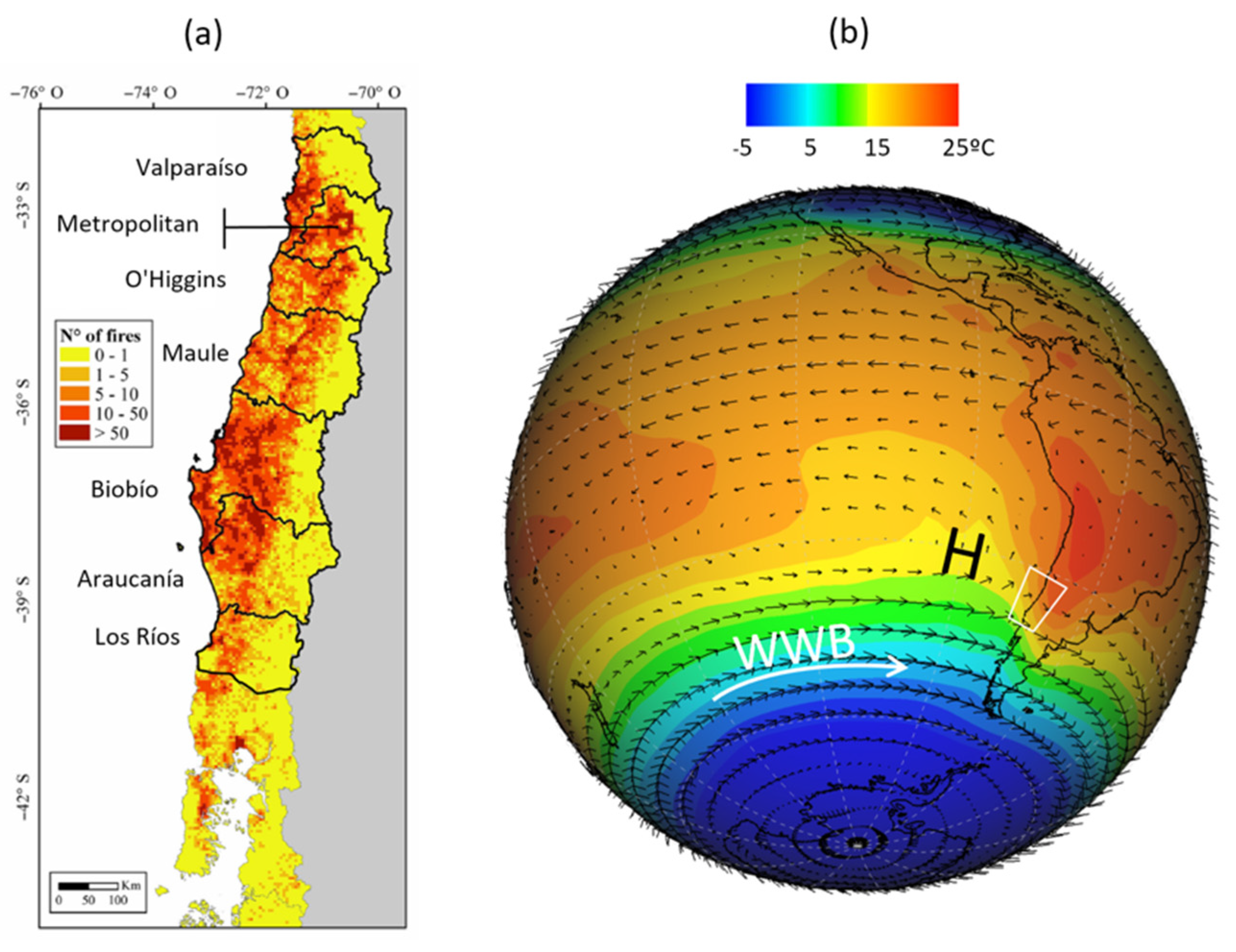

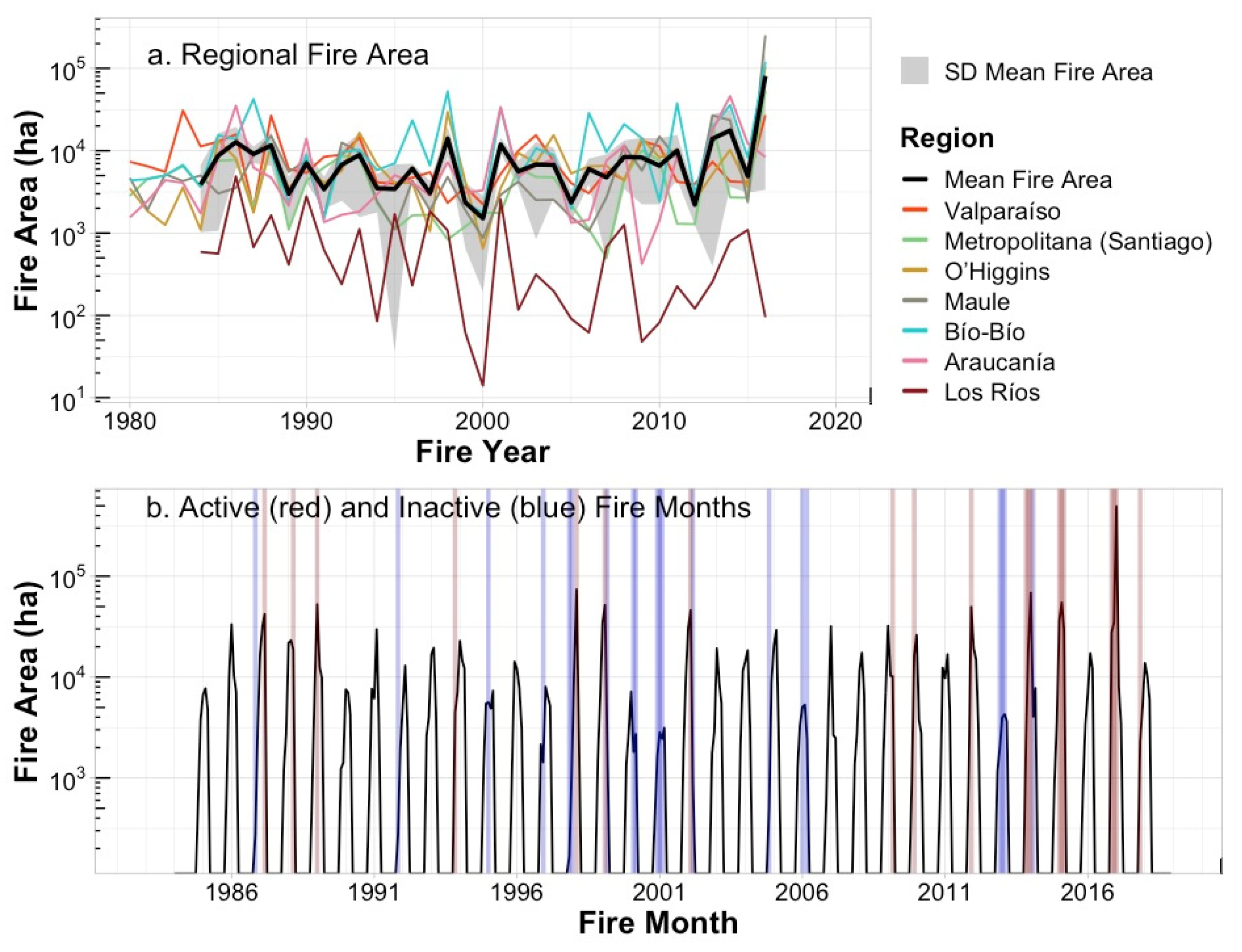
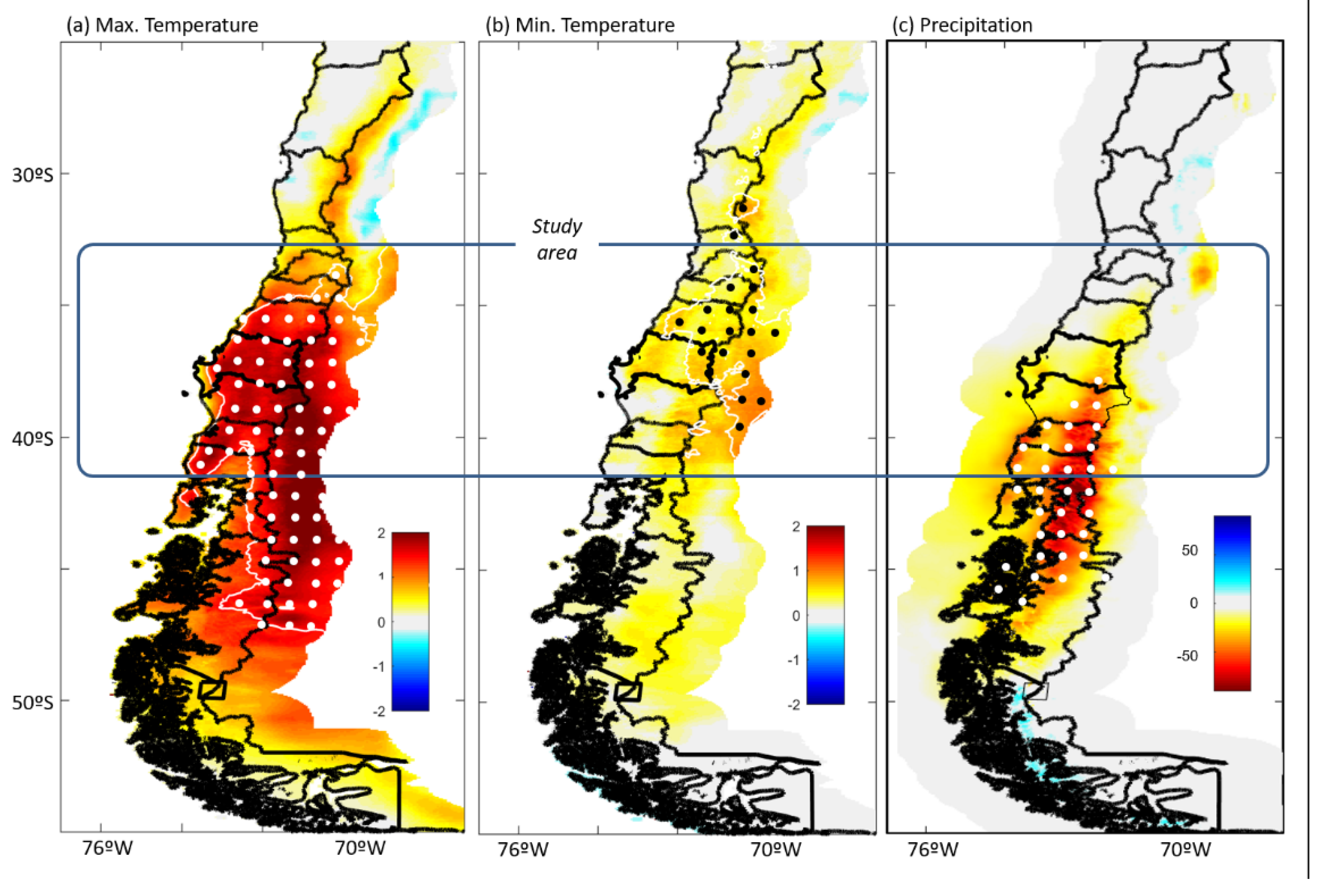
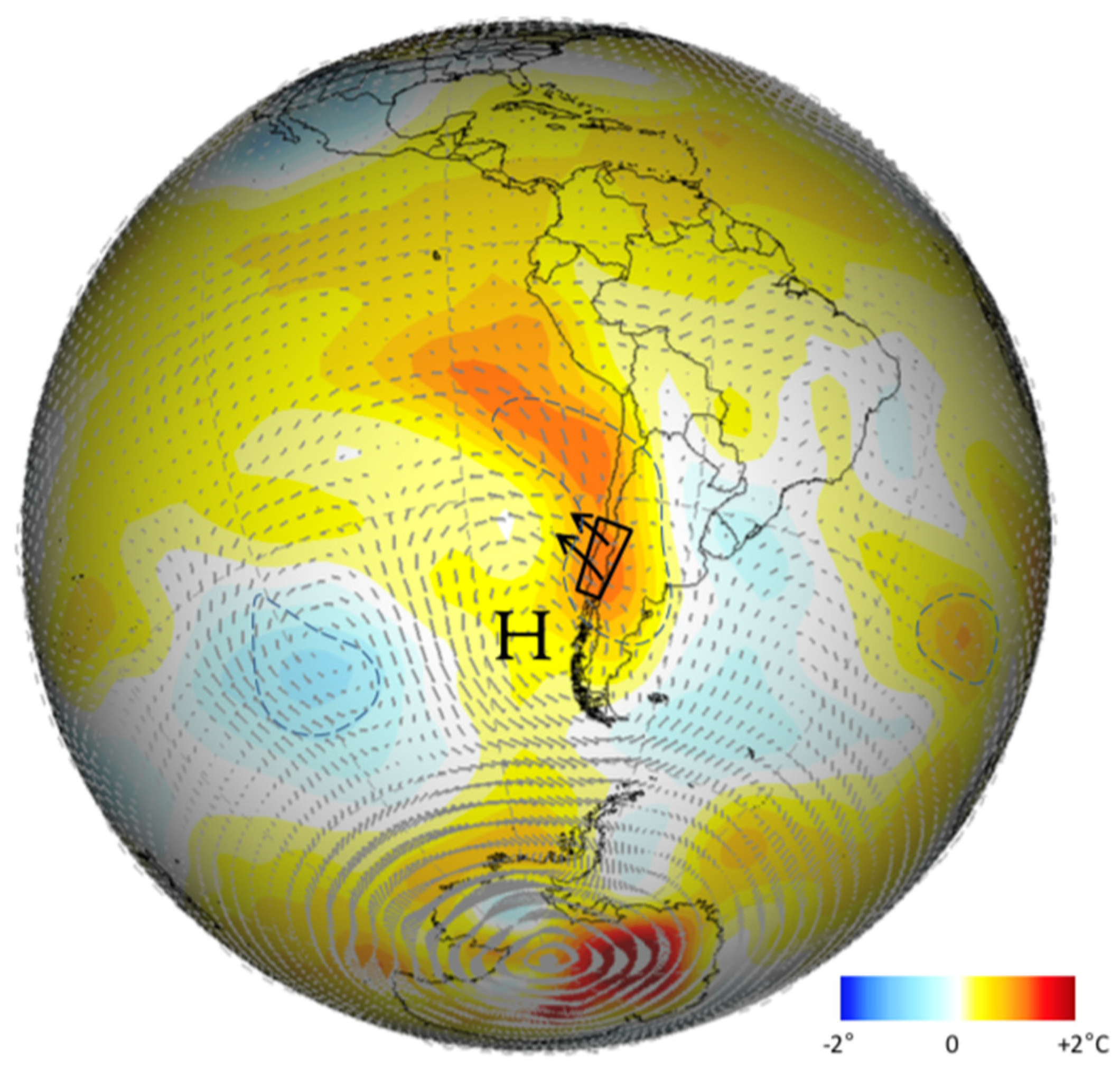
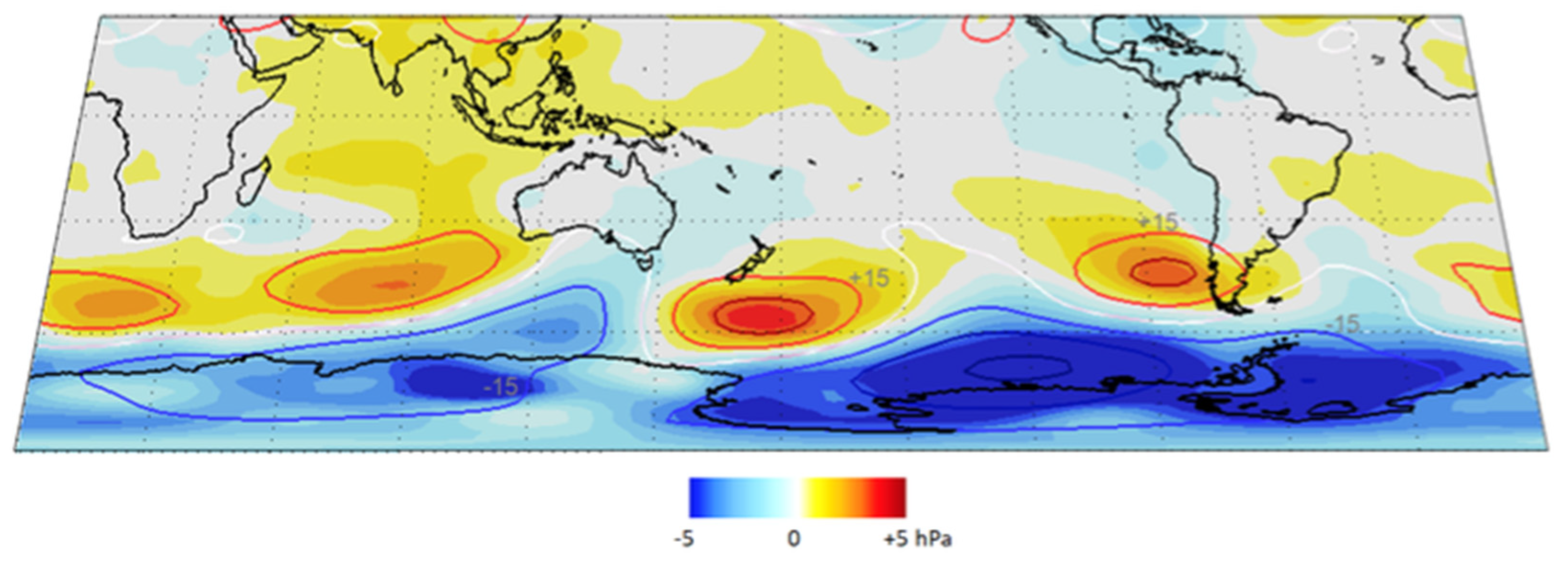
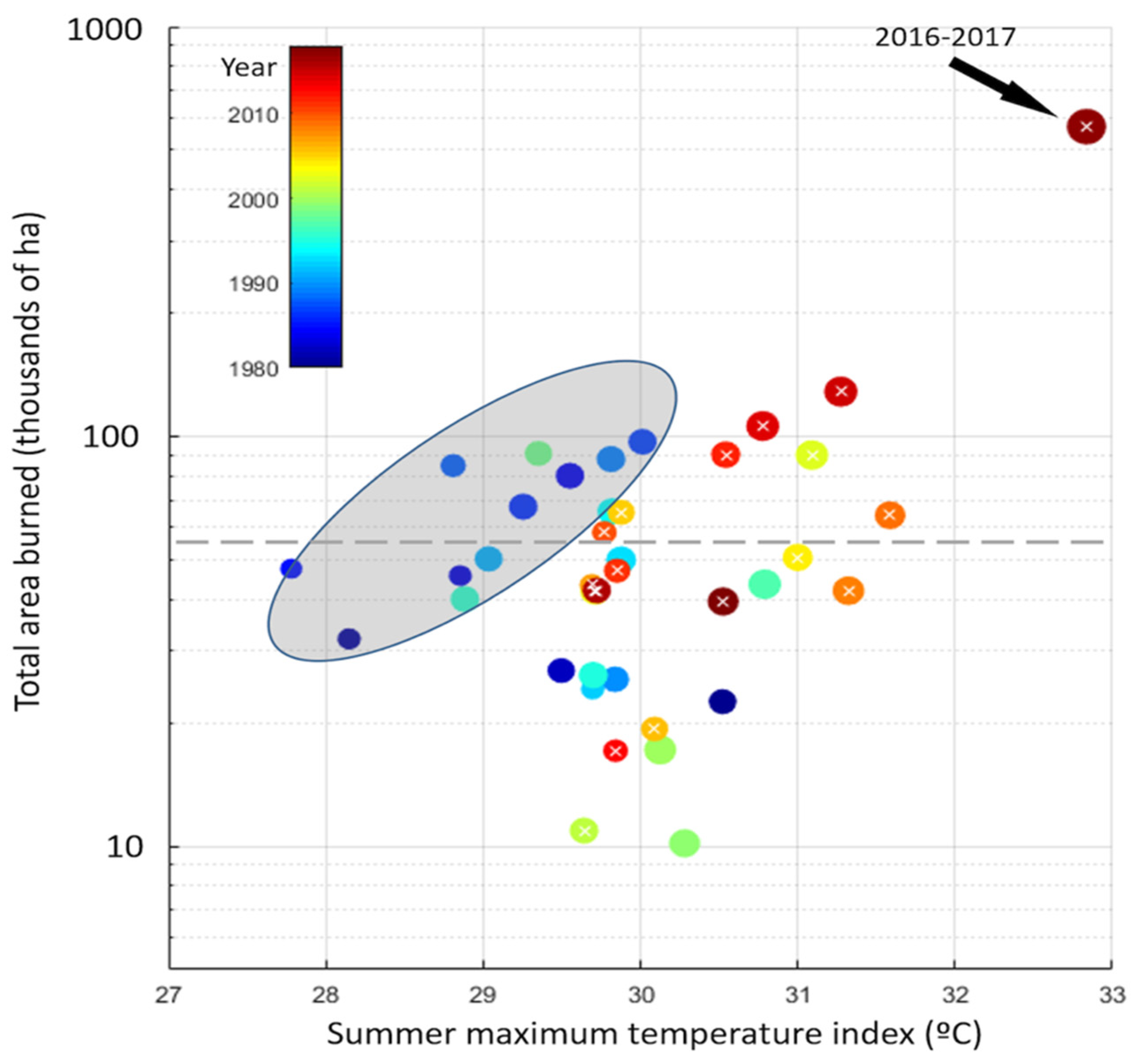
| Administrative District | Area (km2) | Bioclimatic Zone |
|---|---|---|
| Valparaíso | 16,396 | Mediterranean |
| Metropolitana | 15,403 | Mediterranean |
| O’Higgins | 16,387 | Mediterranean |
| Maule | 30,296 | Mediterranean |
| Bío bío | 37,069 | Mediterranean/Temperate |
| Araucanía | 31,842 | Temperate |
| Los Ríos | 18,430 | Temperate |
Publisher’s Note: MDPI stays neutral with regard to jurisdictional claims in published maps and institutional affiliations. |
© 2021 by the authors. Licensee MDPI, Basel, Switzerland. This article is an open access article distributed under the terms and conditions of the Creative Commons Attribution (CC BY) license (https://creativecommons.org/licenses/by/4.0/).
Share and Cite
McWethy, D.B.; Garreaud, R.D.; Holz, A.; Pederson, G.T. Broad-Scale Surface and Atmospheric Conditions during Large Fires in South-Central Chile. Fire 2021, 4, 28. https://0-doi-org.brum.beds.ac.uk/10.3390/fire4020028
McWethy DB, Garreaud RD, Holz A, Pederson GT. Broad-Scale Surface and Atmospheric Conditions during Large Fires in South-Central Chile. Fire. 2021; 4(2):28. https://0-doi-org.brum.beds.ac.uk/10.3390/fire4020028
Chicago/Turabian StyleMcWethy, David B., René D. Garreaud, Andrés Holz, and Gregory T. Pederson. 2021. "Broad-Scale Surface and Atmospheric Conditions during Large Fires in South-Central Chile" Fire 4, no. 2: 28. https://0-doi-org.brum.beds.ac.uk/10.3390/fire4020028






